Java--Spring事务
Posted MinggeQingchun
tags:
篇首语:本文由小常识网(cha138.com)小编为大家整理,主要介绍了Java--Spring事务相关的知识,希望对你有一定的参考价值。
事务原本是数据库中的概念,在Dao层。但Spring框架将事务提升到业务层,即 Service 层
Spring事务的本质其实就是数据库对事务的支持
Spring支持编程式事务管理以及声明式事务管理两种方式
一、编程式事务管理
编程式事务管理是侵入性事务管理,使用TransactionTemplate或者直接使用PlatformTransactionManager,对于编程式事务管理,Spring推荐使用TransactionTemplate
二、声明式事务管理
声明式事务管理建立在AOP之上,其本质是对方法前后进行拦截,然后在目标方法开始之前创建或者加入一个事务,执行完目标方法之后根据执行的情况提交或者回滚。
编程式事务每次实现都要单独实现,但业务量大功能复杂时,使用编程式事务无疑是痛苦的,而声明式事务不同,声明式事务属于无侵入式,不会影响业务逻辑的实现,只需要在配置文件中做相关的事务规则声明或者通过注解的方式,便可以将事务规则应用到业务逻辑中。
显然声明式事务管理要优于编程式事务管理,这正是Spring倡导的非侵入式的编程方式。唯一不足的地方就是声明式事务管理的粒度是方法级别,而编程式事务管理是可以到代码块的,但是可以通过提取方法的方式完成声明式事务管理的配置。
事务定义接口 TransactionDefinition 中定义了事务描述相关的三类常量:事务隔离级别、事务传播行为、事务默认超时时限
事务隔离级别
这些常量均是以 ISOLATION_开头。即形如 ISOLATION_XXX
1、DEFAULT:采用 DB 默认的事务隔离级别。mysql 的默认为 REPEATABLE_READ; Oracle默认为 READ_COMMITTED
2、READ_UNCOMMITTED:读未提交。未解决任何并发问题
3、READ_COMMITTED:读已提交。解决脏读,存在不可重复读与幻读
4、REPEATABLE_READ:可重复读。解决脏读、不可重复读,存在幻读
5、SERIALIZABLE:串行化。不存在并发问题
事务传播行为
事务传播行为是指,处于不同事务中的方法在相互调用时,执行期间事务的维护情况。如,A 事务中的方法 doSome()调用 B 事务中的方法 doOther(),在调用执行期间事务的维护情况,就称为事务传播行为。事务传播行为是加在方法上的
事务传播行为常量都是以 PROPAGATION_ 开头,形如 PROPAGATION_XXX
1、PROPAGATION_REQUIRED
2、PROPAGATION_REQUIRES_NEW
3、PROPAGATION_SUPPORTS
4、PROPAGATION_MANDATORY
5、PROPAGATION_NESTED
6、PROPAGATION_NEVER
7、PROPAGATION_NOT_SUPPORTED
PROPAGATION_REQUIRED:
指定的方法必须在事务内执行。若当前存在事务,就加入到当前事务中;若当前没有事务,则创建一个新事务。这种传播行为是最常见的选择,也是 Spring 默认的事务传播行为。如该传播行为加在 doOther()方法上。若 doSome()方法在调用 doOther()方法时就是在事务内运行的,则 doOther()方法的执行也加入到该事务内执行。若 doSome()方法在调用doOther()方法时没有在事务内执行,则 doOther()方法会创建一个事务,并在其中执行
PROPAGATION_SUPPORTS
指定的方法支持当前事务,但若当前没有事务,也可以以非事务方式执行
PROPAGATION_REQUIRES_NEW
总是新建一个事务,若当前存在事务,就将当前事务挂起,直到新事务执行完毕
事务默认超时时限
表示一个方法最长的执行时间,如果方法执行时超过了时间,事务就回滚。单位是秒, 整数值, 默认是 -1
Spring事务回滚规则
Spring 事务的默认回滚方式是:发生运行时异常和 error 时回滚,发生受查(编译)异常时提交
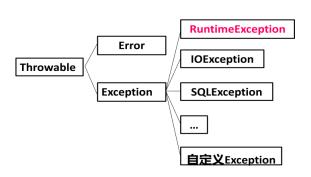
Throwable 类是 Java 语言中所有错误或异常的超类
Error是程序在运行过程中出现的无法处理的错误,比如 OutOfMemoryError、ThreadDeath、NoSuchMethodError 等。当这些错误发生时,程序是无法处理(捕获或抛出),JVM 一般会终止线程
程序在编译和运行时出现的另一类错误称之为异常,它是 JVM 通知程序员的一种方式
异常分为运行时异常与受查异常
运行时异常,是 RuntimeException 类或其子类,即只有在运行时才出现的异常
NullPointerException、ArrayIndexOutOfBoundsException、IllegalArgumentException 等均属于
运行时异常。这些异常由 JVM 抛出,在编译时不要求必须处理(捕获或抛出)
受查异常,也叫编译时异常,即在代码编写时要求必须捕获或抛出的异常,若不处理,则无法通过编译。如 SQLException,ClassNotFoundException,IOException 等都属于受查异常
RuntimeException 及其子类以外的异常,均属于受查异常。自定义的 Exception的子类,即用户自定义的异常也属受查异常。程序员在定义异常时,只要未明确声明定义的为RuntimeException 的子类,那么定义的就是受查异常
事务管理器是 PlatformTransactionManager 接口对象
DataSourceTransactionManager:使用 JDBC 或 MyBatis 进行数据库操作时使用
HibernateTransactionManager:使用 Hibernate 进行持久化数据时使用
1、创建数据库,建一张商品good表和商品销售记录sale_good表
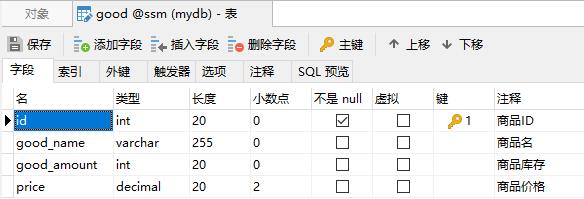
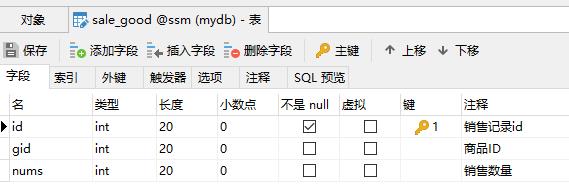
2、新建一个maven项目
3、加入maven的依赖
(1)spring依赖 (2)mybatis依赖 (3)mysql驱动 (4)spring的事务依赖 (5)mybatis和spring集成依赖
4、创建实体类
public class Goods
private Integer id;
private String goodName;
private Integer goodAmount;
private Float price;
public Integer getId()
return id;
public void setId(Integer id)
this.id = id;
public String getGoodName()
return goodName;
public void setGoodName(String goodName)
this.goodName = goodName;
public Integer getGoodAmount()
return goodAmount;
public void setGoodAmount(Integer goodAmount)
this.goodAmount = goodAmount;
public Float getPrice()
return price;
public void setPrice(Float price)
this.price = price;
public class Sale
private Integer id;
private Integer gid;
private Integer nums;
public Integer getId()
return id;
public void setId(Integer id)
this.id = id;
public Integer getGid()
return gid;
public void setGid(Integer gid)
this.gid = gid;
public Integer getNums()
return nums;
public void setNums(Integer nums)
this.nums = nums;
5、创建dao接口和mapper文件
public interface GoodsDao
//更新库存
//goods表示本次用户购买的商品信息, id, 购买数量
int updateGoods(Goods goods);
//查询商品的信息
Goods selectGoods(Integer id);
public interface SaleDao
//增加销售记录
int insertSale(Sale sale);
GoodsDao.xml
<?xml version="1.0" encoding="UTF-8" ?>
<!DOCTYPE mapper
PUBLIC "-//mybatis.org//DTD Mapper 3.0//EN"
"http://mybatis.org/dtd/mybatis-3-mapper.dtd">
<mapper namespace="com.xx.dao.GoodsDao">
<resultMap id="goodMap" type="com.xx.domain.Goods">
<id column="id" property="id" />
<result column="good_name" property="goodName" />
<result column="good_amount" property="goodAmount" />
<result column="price" property="price" />
</resultMap>
<select id="selectGoods" resultMap="goodMap">
select id,good_name,good_amount,price
from good
where id = #gid
</select>
<update id="updateGoods">
update good
set good_amount = good_amount - #goodAmount
where id=#id
</update>
</mapper>SaleDao.xml
<?xml version="1.0" encoding="UTF-8" ?>
<!DOCTYPE mapper
PUBLIC "-//mybatis.org//DTD Mapper 3.0//EN"
"http://mybatis.org/dtd/mybatis-3-mapper.dtd">
<mapper namespace="com.xx.dao.SaleDao">
<insert id="insertSale">
insert into sale_good(gid,nums) values(#gid,#nums)
</insert>
</mapper>6、创建mybatis主配置文件
<?xml version="1.0" encoding="UTF-8" ?>
<!DOCTYPE configuration
PUBLIC "-//mybatis.org//DTD Config 3.0//EN"
"http://mybatis.org/dtd/mybatis-3-config.dtd">
<configuration>
<!-- settings:控制mybatis全局行为 -->
<!--<settings>
<!– 设置mybatis输出日志 –>
<setting name="logImpl" value="STDOUT_LOGGING"/>
</settings>-->
<!-- 定义别名 -->
<typeAliases>
<!-- 第一种方式
指定一个类型为一个自定义别名
type:自定义类型的全限定名称
alias:别名
-->
<!-- <typeAlias type="com.mycompany.domain.User" alias="user" />-->
<!-- 第二种方式
<package>
name:包名,这个包中所有的类,类名就是别名(不区分大小写)
-->
<package name="com.mycompany.domain" />
</typeAliases>
<!--
数据源DataSource 放在spring配置文件中
-->
<!--<environments default="development">
<environment id="online">
<transactionManager type="JDBC"/>
<dataSource type="POOLED">
<property name="driver" value="com.mysql.jdbc.Driver"/>
<property name="url" value="jdbc:mysql://localhost:3306/onlinedb"/>
<property name="username" value="root"/>
<property name="password" value="admin123456"/>
</dataSource>
</environment>
</environments>-->
<!-- sql mapper(SQL映射文件)的位置 -->
<mappers>
<!-- 第一种方式:指定多个mapper文件
一个mapper标签指定一个文件位置
从类路径开始(target/classes)
-->
<!-- <mapper resource="com/mycompany/dao/UserDao.xml" />-->
<!-- 第二种方式:使用包名
name:xml(mapper)文件所在的包名,这个包中所有xml文件一次都能加载给mybatis
使用package要求:
(1)mapper文件名称需要和接口名称一样(区分大小写)
(2)mapper文件和dao接口需要在同一目录
-->
<package name="com.mycompany.dao" />
</mappers>
</configuration>7、创建service接口和实现类,属性是dao
public interface BuyGoodService
//购买商品的方法, goodsId:购买商品的编号, nums:购买的数量
void buy(Integer goodsId,Integer nums);
8、创建spring的配置文件:声明mybatis对象交给spring创建 (1)数据源DataSource (2)SqlSessionFactory (3)Dao对象 (4)声明自定义的service
jdbc.properties数据库的属性配置文件
jdbc.driver=com.mysql.jdbc.Driver
jdbc.url=jdbc:mysql://localhost:3306/ssm
jdbc.user=root
jdbc.password=123456
jdbc.maxActive=209、创建测试类
public class TestTransaction
@Test
public void testTransaction()
String config = "applicationContext.xml";
ApplicationContext ac = new ClassPathXmlApplicationContext(config);
//获取容器中所有对象名
String names[] = ac.getBeanDefinitionNames();
for (String name:names)
System.out.println("容器中对象名称:" + name + " " + ac.getBean(name));
//从容器获取service
BuyGoodService service = (BuyGoodService) ac.getBean("buyGoodService");
//调用方法
service.buy(1001,10);
在 Spring 中通常可以通过以下两种方式来实现对事务的管理(如上步骤创建项目或者模块,如下两种方式区别之处在下面使用事务过程中会单独区分说明)
一、使用 Spring 的事务注解管理事务
@Transactional注解方案适合中小项目使用
spring框架用aop实现给业务方法增加事务的功能, 使用@Transactional注解增加事务
使用@Transactional的步骤:
1、需要声明事务管理器对象
<bean id="xx" class="DataSourceTransactionManager">2、开启事务注解驱动, 告诉spring框架,我要使用注解的方式管理事务
spring使用aop机制,创建@Transactional所在的类代理对象,给方法加入事务的功能
spring给业务方法加入事务:
在业务方法执行之前,先开启事务,在业务方法之后提交或回滚事务,使用aop的环绕通知
@Around("要增加的事务功能的业务方法名称")
Object myAround()
//spring开启事务
try
buy(1001,10);
spring的事务管理器.commit();
catch(Exception e)
spring的事务管理器.rollback();
通过@Transactional 注解方式,可将事务植入到相应 public 方法中,实现事务管理
@Transactional 的所有可选属性如下
propagation:用于设置事务传播属性。该属性类型为 Propagation 枚举,默认值为
Propagation.REQUIRED。
isolation:用于设置事务的隔离级别。该属性类型为 Isolation 枚举,默认值为
Isolation.DEFAULT
readOnly:用于设置该方法对数据库的操作是否是只读的。该属性为 boolean,默认值
为 false
timeout:用于设置本操作与数据库连接的超时时限。单位为秒,类型为 int,默认值为
-1,即没有时限
rollbackFor:指定需要回滚的异常类。类型为 Class[],默认值为空数组。当然,若只有
一个异常类时,可以不使用数组
rollbackForClassName:指定需要回滚的异常类类名。类型为 String[],默认值为空数组。
当然,若只有一个异常类时,可以不使用数组
noRollbackFor:指定不需要回滚的异常类。类型为 Class[],默认值为空数组。当然,若
只有一个异常类时,可以不使用数组
noRollbackForClassName:指定不需要回滚的异常类类名。类型为 String[],默认值为空
数组。当然,若只有一个异常类时,可以不使用数组
注:
1、@Transactional 若用在方法上,只能用于 public 方法上。对于其他非public方法,如果加上了注解@Transactional,虽然 Spring 不会报错,但不会将指定事务植入到该方法中。Spring 会忽略掉所有非 public 方法上的@Transaction 注解
2、若@Transaction 注解在类上,则表示该类上所有的方法均将在执行时植入事务
第2步加入依赖
<dependencies>
<!-- 单元测试依赖 -->
<dependency>
<groupId>junit</groupId>
<artifactId>junit</artifactId>
<version>4.11</version>
<scope>test</scope>
</dependency>
<!--spring依赖 核心IoC-->
<dependency>
<groupId>org.springframework</groupId>
<artifactId>spring-context</artifactId>
<version>5.2.5.RELEASE</version>
</dependency>
<!-- spring事务 -->
<dependency>
<groupId>org.springframework</groupId>
<artifactId>spring-tx</artifactId>
<version>5.2.5.RELEASE</version>
</dependency>
<dependency>
<groupId>org.springframework</groupId>
<artifactId>spring-jdbc</artifactId>
<version>5.2.5.RELEASE</version>
</dependency>
<!-- mybatis事务 -->
<dependency>
<groupId>org.mybatis</groupId>
<artifactId>mybatis</artifactId>
<version>3.5.1</version>
</dependency>
<!-- spring和mybatis集成依赖 -->
<dependency>
<groupId>org.mybatis</groupId>
<artifactId>mybatis-spring</artifactId>
<version>2.0.1</version>
</dependency>
<!-- mysql驱动 -->
<dependency>
<groupId>mysql</groupId>
<artifactId>mysql-connector-java</artifactId>
<version>5.1.9</version>
</dependency>
<!-- 阿里数据库连接池Druid -->
<dependency>
<groupId>com.alibaba</groupId>
<artifactId>druid</artifactId>
<version>1.2.6</version>
</dependency>
</dependencies>第7步创建service类和实现类;主要使用@Transactional注解
public class BuyGoodServiceImpl implements BuyGoodService
private SaleDao saleDao;
private GoodsDao goodsDao;
public void setSaleDao(SaleDao saleDao)
this.saleDao = saleDao;
public void setGoodsDao(GoodsDao goodsDao)
this.goodsDao = goodsDao;
/**
rollbackFor:表示发生的指定异常一定回滚
原理:
(1)spring框架首先会检查方法抛出的异常是不是在rollbackFor的属性值中
如果异常在rollbackFor列表中,不管什么类型异常,一定回滚
(2)如果抛出的异常不在rollbackFor列表中,spring会判断异常是不是RuntimeException
如果是一定回滚
*/
/*@Transactional(
propagation = Propagation.REQUIRED,//事务传播行为
isolation = Isolation.DEFAULT,//事务隔离级别
readOnly = false,//对数据库的操作是否是只读
rollbackFor = //指定需要回滚的异常类。类型为 Class[],默认值为空数组
NullPointerException.class,
NotEnoughException.class
)*/
/**
使用事务控制的默认值,默认传播行为是REQUIRED,默认隔离级别是DEFAULT,默认抛出运行时异常回滚事务
*/
@Transactional
@Override
public void buy(Integer goodsId, Integer nums)
System.out.println("=====buy方法的开始====");
//记录销售信息,向sale表添加记录
Sale sale = new Sale();
sale.setGid(goodsId);
sale.setNums(nums);
saleDao.insertSale(sale);
//更新库存
Goods goods = goodsDao.selectGoods(goodsId);
if( goods == null)
//商品不存在
throw new NullPointerException("编号是:"+goodsId+",商品不存在");
else if(goods.getGoodAmount() < nums)
//商品库存不足
throw new NotEnoughException("编号是:"+goodsId+",商品库存不足");
//修改库存了
Goods buyGoods = new Goods();
buyGoods.setId( goodsId);
buyGoods.setGoodAmount(nums);
goodsDao.updateGoods(buyGoods);
System.out.println("=====buy方法的结束====");
第8步,创建spring配置文件;主要使用<tx:annotation-driven>
这里要特别注意<tx:annotation-driven>的选择

<?xml version="1.0" encoding="UTF-8"?>
<beans xmlns="http://www.springframework.org/schema/beans"
xmlns:xsi="http://www.w3.org/2001/XMLSchema-instance"
xmlns:context="http://www.springframework.org/schema/context" xmlns:tx="http://www.springframework.org/schema/tx"
xsi:schemaLocation="http://www.springframework.org/schema/beans
http://www.springframework.org/schema/beans/spring-beans.xsd
http://www.springframework.org/schema/context
https://www.springframework.org/schema/context/spring-context.xsd
http://www.springframework.org/schema/tx
http://www.springframework.org/schema/tx/spring-tx.xsd">
<!--
spring加载数据库的属性配置文件
-->
<context:property-placeholder location="classpath:jdbc.properties" />
<!--1、声明数据源DataSource,作用:连接数据库
将mybatis主配置文件 configuration 下的environments 标签内容移到了这里
Druid官网:https://github.com/alibaba/druid
DruidDataSource配置:https://github.com/alibaba/druid/wiki/DruidDataSource%E9%85%8D%E7%BD%AE
-->
<bean id="myDataSource" class="com.alibaba.druid.pool.DruidDataSource"
init-method="init" destroy-method="close">
<!-- set注入给DruidDataSource提供数据库连接信息 -->
<!-- 使用属性配置文件中的数据,语法 $key -->
<property name="url" value="$jdbc.url" />
<property name="username" value="$jdbc.user" />
<property name="password" value="$jdbc.password" />
<property name="maxActive" value="$jdbc.maxActive" />
</bean>
<!--2、声明mybatis中提供的SqlSessionFactoryBean类 -->
<bean id="sqlSessionFactory" class="org.mybatis.spring.SqlSessionFactoryBean" >
<!-- set注入,将数据库连接池赋给dataSource属性 -->
<property name="dataSource" ref="myDataSource" />
<!-- mybatis主配置文件位置
configLocation 属性是Resource类型读取配置文件
使用value赋值,指定文件路径,使用 classpath: 表示文件位置
-->
<property name="configLocation" value="classpath:mybatis-config.xml" />
</bean>
<!--3、创建dao对象,使用SqlSession的getMapper(xxDao.class)
MapperScannerConfigurer:内部调用getMapper()方法生成每个dao接口的代理对象
-->
<bean class="org.mybatis.spring.mapper.MapperScannerConfigurer">
<!-- 指定SqlSession对象的id -->
<property name="sqlSessionFactoryBeanName" value="sqlSessionFactory" />
<!-- 指定包名,dao接口所在的包名
MapperScannerConfigurer会扫描这个包中的所有接口,把每个接口都执行一次getMapper()方法,
得到每个接口的dao对象
创建好的dao对象放入到spring容器中;dao对象的默认名称是 接口名首字母小写!!!
-->
<property name="basePackage" value="com.mycompany.dao" />
</bean>
<!--4、声明service -->
<bean id="buyGoodService" class="com.mycompany.service.impl.BuyGoodServiceImpl">
<!-- 通过MapperScannerConfigurer 扫描包;dao对象的默认名称是 接口名首字母小写!!! -->
<property name="saleDao" ref="saleDao" />
<property name="goodsDao" ref="goodsDao" />
</bean>
<!-- 使用Spring的事务处理 -->
<!-- 1、声明事务管理器 -->
<bean id="transactionManager" class="org.springframework.jdbc.datasource.DataSourceTransactionManager">
<!-- 连接的数据库,指定数据源 -->
<property name="dataSource" ref="myDataSource" />
</bean>
<!-- 2、开启事务注解驱动(告诉spring使用注解管理事务,创建代理对象)
transaction-manager:事务管理器对象的id
tx:annotation-driven 需要选择 http://www.springframework.org/schema/tx
-->
<tx:annotation-driven transaction-manager="transactionManager" />
</beans>二、使用 AspectJ 的 AOP 配置管理事务
适合大型项目,有很多的类,方法,需要大量的配置事务,使用aspectj框架功能,在spring配置文件中声明类,方法需要的事务。这种方式业务方法和事务配置完全分离
实现步骤: 都是在xml配置文件中实现
1、使用的是aspectj框架,需要加入依赖
<dependency>
<groupId>org.springframework</groupId>
<artifactId>spring-aspects</artifactId>
<version>5.2.5.RELEASE</version>
</dependency>2、声明事务管理器对象
<bean id="xx" class="DataSourceTransactionManager">3、声明方法需要的事务类型(配置方法的事务属性【隔离级别,传播行为,超时】)
4、配置aop:指定哪些哪类要创建代理
第2步加入依赖;变化:加入了aspectj依赖
<dependencies>
<!-- 单元测试依赖 -->
<dependency>
<groupId>junit</groupId>
<artifactId>junit</artifactId>
<version>4.11</version>
<scope>test</scope>
</dependency>
<!--spring依赖 核心IoC-->
<dependency>
<groupId>org.springframework</groupId>
<artifactId>spring-context</artifactId>
<version>5.2.5.RELEASE</version>
</dependency>
<!--aspectj依赖-->
<dependency>
<groupId>org.springframework</groupId>
<artifactId>spring-aspects</artifactId>
<version>5.2.5.RELEASE</version>
</dependency>
<!-- spring事务 -->
<dependency>
<groupId>org.springframework</groupId>
<artifactId>spring-tx</artifactId>
<version>5.2.5.RELEASE</version>
</dependency>
<dependency>
<groupId>org.springframework</groupId>
<artifactId>spring-jdbc</artifactId>
<version>5.2.5.RELEASE</version>
</dependency>
<!-- mybatis事务 -->
<dependency>
<groupId>org.mybatis</groupId>
<artifactId>mybatis</artifactId>
<version>3.5.1</version>
</dependency>
<!-- spring和mybatis集成依赖 -->
<dependency>
<groupId>org.mybatis</groupId>
<artifactId>mybatis-spring</artifactId>
<version>2.0.1</version>
</dependency>
<!-- mysql驱动 -->
<dependency>
<groupId>mysql</groupId>
<artifactId>mysql-connector-java</artifactId>
<version>5.1.9</version>
</dependency>
<!-- 阿里数据库连接池Druid -->
<dependency>
<groupId>com.alibaba</groupId>
<artifactId>druid</artifactId>
<version>1.2.6</version>
</dependency>
</dependencies>第7步创建service类和实现类;没有使用@Transactional注解
public class BuyGoodServiceImpl implements BuyGoodService
private SaleDao saleDao;
private GoodsDao goodsDao;
public void setSaleDao(SaleDao saleDao)
this.saleDao = saleDao;
public void setGoodsDao(GoodsDao goodsDao)
this.goodsDao = goodsDao;
@Override
public void buy(Integer goodsId, Integer nums)
System.out.println("=====buy方法的开始====");
//记录销售信息,向sale表添加记录
Sale sale = new Sale();
sale.setGid(goodsId);
sale.setNums(nums);
saleDao.insertSale(sale);
//更新库存
Goods goods = goodsDao.selectGoods(goodsId);
if( goods == null)
//商品不存在
throw new NullPointerException("编号是:"+goodsId+",商品不存在");
else if(goods.getGoodAmount() < nums)
//商品库存不足
throw new NotEnoughException("编号是:"+goodsId+",商品库存不足");
//修改库存了
Goods buyGoods = new Goods();
buyGoods.setId( goodsId);
buyGoods.setGoodAmount(nums);
goodsDao.updateGoods(buyGoods);
System.out.println("=====buy方法的结束====");
第8步,创建spring配置文件;主要使用<tx:advice>和<aop:config>
这里需要注意选择<tx:advice>
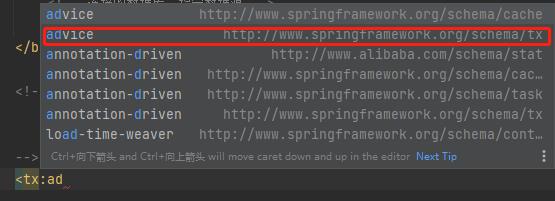
<?xml version="1.0" encoding="UTF-8"?>
<beans xmlns="http://www.springframework.org/schema/beans"
xmlns:xsi="http://www.w3.org/2001/XMLSchema-instance"
xmlns:context="http://www.springframework.org/schema/context"
xmlns:tx="http://www.springframework.org/schema/tx" xmlns:util="http://www.springframework.org/schema/util"
xmlns:aop="http://www.springframework.org/schema/aop"
xsi:schemaLocation="http://www.springframework.org/schema/beans
http://www.springframework.org/schema/beans/spring-beans.xsd
http://www.springframework.org/schema/context
https://www.springframework.org/schema/context/spring-context.xsd
http://www.springframework.org/schema/tx
http://www.springframework.org/schema/tx/spring-tx.xsd http://www.springframework.org/schema/util https://www.springframework.org/schema/util/spring-util.xsd http://www.springframework.org/schema/aop https://www.springframework.org/schema/aop/spring-aop.xsd">
<!--
spring加载数据库的属性配置文件
-->
<context:property-placeholder location="classpath:jdbc.properties" />
<!--1、声明数据源DataSource,作用:连接数据库
将mybatis主配置文件 configuration 下的environments 标签内容移到了这里
Druid官网:https://github.com/alibaba/druid
DruidDataSource配置:https://github.com/alibaba/druid/wiki/DruidDataSource%E9%85%8D%E7%BD%AE
-->
<bean id="myDataSource" class="com.alibaba.druid.pool.DruidDataSource"
init-method="init" destroy-method="close">
<!-- set注入给DruidDataSource提供数据库连接信息 -->
<!-- 使用属性配置文件中的数据,语法 $key -->
<property name="url" value="$jdbc.url" />
<property name="username" value="$jdbc.user" />
<property name="password" value="$jdbc.password" />
<property name="maxActive" value="$jdbc.maxActive" />
</bean>
<!--2、声明mybatis中提供的SqlSessionFactoryBean类 -->
<bean id="sqlSessionFactory" class="org.mybatis.spring.SqlSessionFactoryBean" >
<!-- set注入,将数据库连接池赋给dataSource属性 -->
<property name="dataSource" ref="myDataSource" />
<!-- mybatis主配置文件位置
configLocation 属性是Resource类型读取配置文件
使用value赋值,指定文件路径,使用 classpath: 表示文件位置
-->
<property name="configLocation" value="classpath:mybatis-config.xml" />
</bean>
<!--3、创建dao对象,使用SqlSession的getMapper(xxDao.class)
MapperScannerConfigurer:内部调用getMapper()方法生成每个dao接口的代理对象
-->
<bean class="org.mybatis.spring.mapper.MapperScannerConfigurer">
<!-- 指定SqlSession对象的id -->
<property name="sqlSessionFactoryBeanName" value="sqlSessionFactory" />
<!-- 指定包名,dao接口所在的包名
MapperScannerConfigurer会扫描这个包中的所有接口,把每个接口都执行一次getMapper()方法,
得到每个接口的dao对象
创建好的dao对象放入到spring容器中;dao对象的默认名称是 接口名首字母小写!!!
-->
<property name="basePackage" value="com.mycompany.dao" />
</bean>
<!--4、声明service -->
<bean id="buyGoodService" class="com.mycompany.service.impl.BuyGoodServiceImpl">
<!-- 通过MapperScannerConfigurer 扫描包;dao对象的默认名称是 接口名首字母小写!!! -->
<property name="saleDao" ref="saleDao" />
<property name="goodsDao" ref="goodsDao" />
</bean>
<!-- 声明式事务处理:和源代码完全分离 -->
<!--1、声明事务管理器对象-->
<bean id="treansactionManager" class="org.springframework.jdbc.datasource.DataSourceTransactionManager">
<!-- 连接的数据库,指定数据源 -->
<property name="dataSource" ref="myDataSource" />
</bean>
<!--2、声明业务方法的事务属性(隔离级别,传播行为,超时时间等)
id:自定义名称;表示 <tx:advice>和</tx:advice>之间的配置内容
transaction-manager:事务管理器对象的id
tx:advice 需要选择 http://www.springframework.org/schema/tx
-->
<tx:advice id="myAdvice" transaction-manager="treansactionManager">
<!-- tx:attributes :配置事务属性 -->
<tx:attributes>
<!-- tx:method:给具体的方法配置事务属性,method可以有多个,分别给不同的方法设置事务属性
name:方法名称
(1)完整的方法名称,不带有包和类
(2)方法可以使用通配符* ,* 表示任意字符
propagation:传播行为,枚举值
isolation:隔离级别
rollback-for:指定的异常名,全限定名;发生异常一定回滚
-->
<tx:method name="buy" propagation="REQUIRED" isolation="DEFAULT"
rollback-for="java.lang.NullPointerException,com.mycompany.exception.NotEnoughException"/>
<!-- 使用通配符,指定 -->
<tx:method name="add*" />
</tx:attributes>
</tx:advice>
<!-- 配置aop -->
<aop:config>
<!-- 配置切入点表达式,指定哪些包中类,使用事务
id:切入点表达式的名称,唯一值
expression:切入点表达式,指定哪些类使用方法,aspectj会创建代理对象
-->
<aop:pointcut id="servicePt" expression="execution(* *..service..*.*(..))"/>
<!-- 配置增强器:关联advice和PointCut
advice-ref:通知,tx:advice 的配置
pointcut-ref:切入点表达式的id
-->
<aop:advisor advice-ref="myAdvice" pointcut-ref="servicePt" />
</aop:config>
</beans>我们没使用事务,会发现商品库存没有减少,但是新增了销售记录
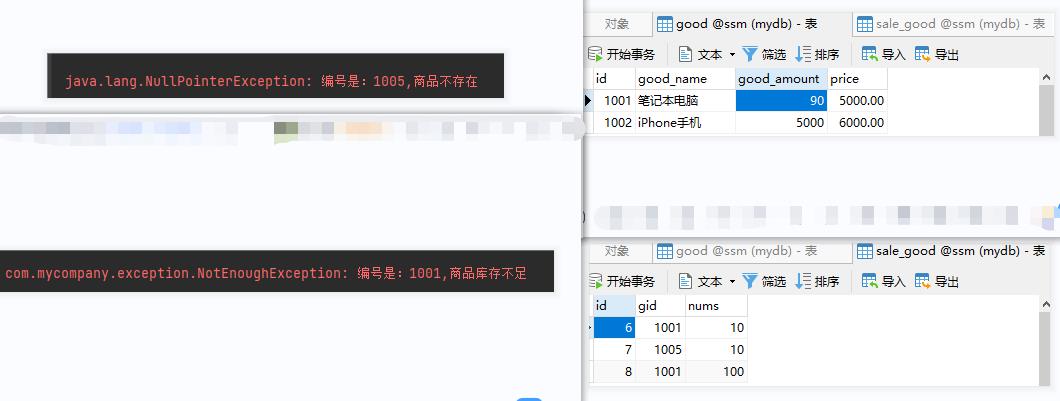
使用事务机制之后,会发现库存没有减少,但是商品销售记录表的id由12增到了15,是因为中间运行了两次异常,一次为库存不足异常,一次为商品不存在异常

以上是关于Java--Spring事务的主要内容,如果未能解决你的问题,请参考以下文章